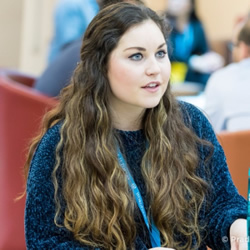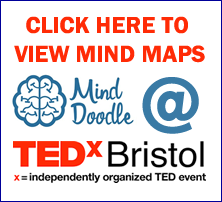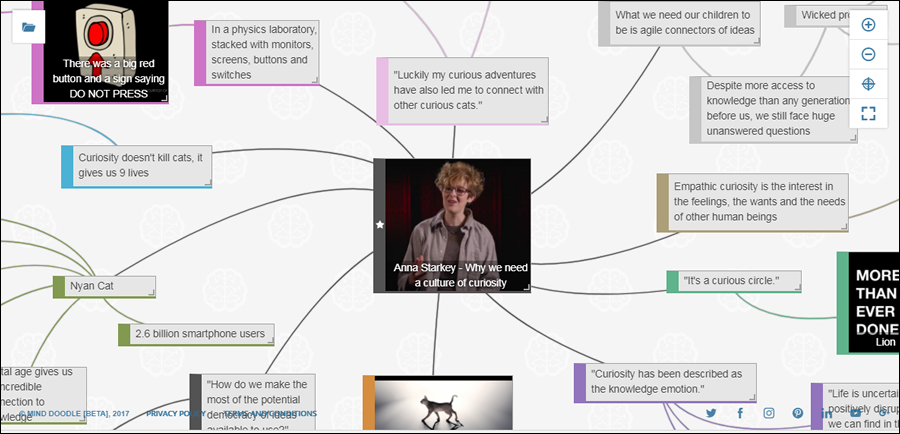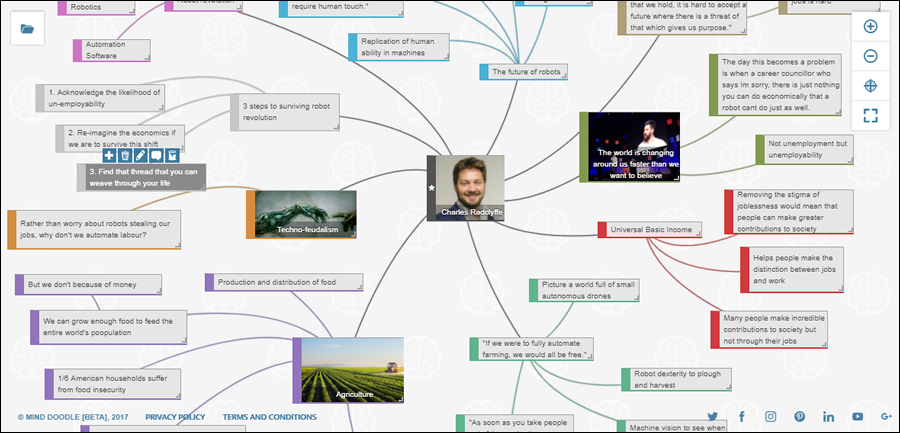Mind maps recently added an intriguing new element to the TEDxBristol event in the UK, thanks to Mind Doodle, a web-based mind mapping tool. As Mind Doodle staff translated each speaker’s presentations into visual notes, on-site and remote attendees could watch the maps grow in real time. They can also access an archive of mind maps from this important regional conference, held in Bristol, UK.
 I recently talked to Tess Coughlan-Allen, Mind Doodle’s marketing manager, to learn more about the genesis of this great idea, how they did it and the benefits to attendees.
I recently talked to Tess Coughlan-Allen, Mind Doodle’s marketing manager, to learn more about the genesis of this great idea, how they did it and the benefits to attendees.
Chuck Frey: Where did the idea to live map these presentations first come from? Mind Doodle or TEDxBristol?
Tess Coughlan-Allen: When we heard that TEDx was coming to Bristol, our first thought was that we wanted to attend, because TED and TEDx events have an incredible reputation for fascinating and stimulating talks. Shortly after this, one of our contacts from the Bristol community got in touch to tell us she was a part of the TEDxBristol organising team.
We started discussing the options for getting more heavily involved with the TEDx organisers and quickly realised that we share the same key values and beliefs: that powerful ideas should be shared by, and accessible to, everyone.
We decided that TEDxBristol was an opportunity we couldn’t refuse, and agreed that we could support in two ways:
Firstly, by live mind mapping the talks, we were able to enhance the audience experience for both direct attendees and for those following the TEDx event online globally.
Secondly, we supported the Community Partnership Programme by contributing towards providing 15% of seats to people from Bristol and the West’s diverse community groups for free.
Chuck: What is TEDxBristol’s Community Partnership Programme? What are its objectives and how does live mapping its presentations fit into its mission?
Tess: The Community Partnership Programme was a fantastic initiative by TEDxBristol to help make the event accessible to diverse community groups in Bristol, therefore sharing the ideas with more than just the people who can afford to buy a ticket.
Mind Doodle contributed to the Community Partnership Programme, along with other sponsors, to provide free tickets for individuals from around Bristol and the South West.
There were a total of 260 people who managed to attend the event through the programme, who could not have attended the event otherwise. We interviewed two attendees who benefited from free tickets, which you can read here.
By live mind mapping the event, we were able to further amplify the cutting-edge ideas that were explored in the talks to an audience who are outside of the local community.
Chuck: What are the advantages of capturing the essence of a talk in a mind map as opposed to other visual or written format?
Tess: Thinking is not necessarily a linear process. Similarly, the way that we absorb information varies and traditional methods of planning, thinking and working are out of date.
By capturing the essence of the TEDx talks through mind mapping, we helped to widen the appeal and understanding of the talks.
Mind mapping is a reasonably well-understood concept now. It is not alien to most people, and the benefits of mind mapping are evident.
We’ve embraced the simple and powerful idea of mind mapping, but taken things a step further. Our software moves forward from the basic concept of mind mapping to build a collaborative thinking environment.
It is easy to use, communication between team members is instantaneous and most importantly, it enables both a holistic view of the ‘bigger picture’ and the ability to focus closely on each individual idea.
Chuck: Are there some challenges, too?
Tess: There are always challenges when introducing a new and innovative software product. With such a flexible tool, the biggest obstacle is explaining how all of the different features can be best utilised.
There is potential for new digital tools to generate a fear factor for new users, but Mind Doodle is so natural that you can easily transfer your ideas from your consciousness and allow your thoughts to flow freely. We have found that once people have seen Mind Doodle in action, its advantages and the scope of possibility it affords the user becomes self-evident.
We noticed there is usually a lot of friction when you move from creating an idea to sharing an idea, for example when you write things up, email, attach files and discuss. Equally, when you go from the concept through to planning, again, you are normally forced to use a new planning tool. We saw that there was a need for a streamlined process from initial idea creation right through to execution.
You can use Mind Doodle to create an idea and then transition the idea from something only you have into something tangible that can be expanded upon by other colleagues and contributors. What we’ve done is pull together what are currently discreet processes into one seamless tool.
Chuck: Does it take a special skill set to capture the essence of a speaker’s presentation, live. in a mind map?
Tess: Absolutely not, Mind Doodle is for everyone and is simple and intuitive to use, and anyone can live mind map speaker presentations.
However, as live mind mapping is time sensitive, it works best if the mind mapper is someone who has standard computer skills, who can touch type and has the capability to understand what is being presented quickly, but anyone can do it.
You can also prepare for events like these. For example, we met all of the speakers before the event and showed them what we planned to do. They briefed us on their talks and were really excited about having their thoughts mapped out visually. The mind maps became a resource that the speakers wanted to share in the future, too!
Chuck: Your news release said that attendees, visitors and the global audience were able to watch these mind maps develop in real time. What platform did you use for live sharing?
Tess: That’s right, anyone could watch the mind maps develop in real time. It all happened within Mind Doodle and it was as simple as typing in the URL and choosing the mind map from the list.
We also posted across social media with links to the mind maps that we were creating live, so anyone could access the latest mind maps as we were creating them.
Chuck: It sounds like there were hundreds of remote locations watching the speakers live. Did they also see your mind maps?
Tess: Yes, they just needed to visit https://tedxbristol.minddoodle.com to have access to the mind maps. Alongside the organisers of TEDxBristol, we promoted the idea of the live mind mapping to increase awareness and widen the TEDx audience as much as possible.
We had thousands of visitors to Mind Doodle who watched the mind maps as they developed and we were pleased to be able to provide so many people with visual access to the talks in real time.
Chuck: How will this use of online mind mapping help to “ignite new ideas and inspire new conversations,” as your news release says?
Tess: Seeing something demonstrated in the live environment is inspirational, it makes ideas spread and almost feels contagious.
Live mapping with Mind Doodle allowed people to see what modern tools can do for them to help with the core process of thinking. The way in which we think is something that we need to improve across the world. Core thinking can be difficult to do, which is why there was a need for a software tool to simplify and enable it.
For inspiring new conversations, that’s where our chat tool came in. Within each idea in our mind maps, there is a live chat, allowing people to discuss, share and comment immediately. This meant online viewers and attendees could further explore the ideas that the TEDxBristol speakers presented.
Chuck: How have you determined if the live mapping experiment was successful or not?
Tess: Fundamentally, it was down to the feedback from remote users, audience members and speakers so we judged it by how useful it was based on user feedback.
We wanted to know if the live mind mapping helped people to understand concepts and interpret key facts from the presentations more quickly and evaluate whether anything got in the way, weighing up how much value was added by the live mind mapping.
We’ve had overwhelmingly positive feedback so far, particularly from attendees at the event. The speakers also gave us extremely positive feedback, saying the mind maps helped them to communicate their ideas effectively. Many of them wanted to share the mind maps further within their own networks.
Overall, our main aim was to amplify the powerful messages from TEDx to a wider audience. The talks covered a range of topics from science to business, technology and global issues and we helped to widen the access and improve the audience experience for these talks, so we consider it a success.
Chuck: Live mapping presentations looks like the type of enhancement that other TEDx events could easily replicate. Do you plan to share the backstory of it with the TEDx network, to amplify this innovative approach to knowledge sharing?
Tess: Yes, definitely. Mind Doodle enhanced the experience of both the attendees and those following TEDx worldwide and looking at the data, the positive reaction to the mind maps shows us that this is a natural progression. Of course, anyone is welcome to use our tool, even if we don’t do the mind mapping ourselves.
 Chuck: Where can readers of the Mind Mapping Software Blog view these mind maps, live and in archived format?
Chuck: Where can readers of the Mind Mapping Software Blog view these mind maps, live and in archived format?
Tess: The mind maps are available at https://tedxbristol.minddoodle.com and will remain here as a resource for anyone to access key ideas and quotes. This means that the ideas from the event are contained in a digital archive and free to access in the future.




Leave a Reply